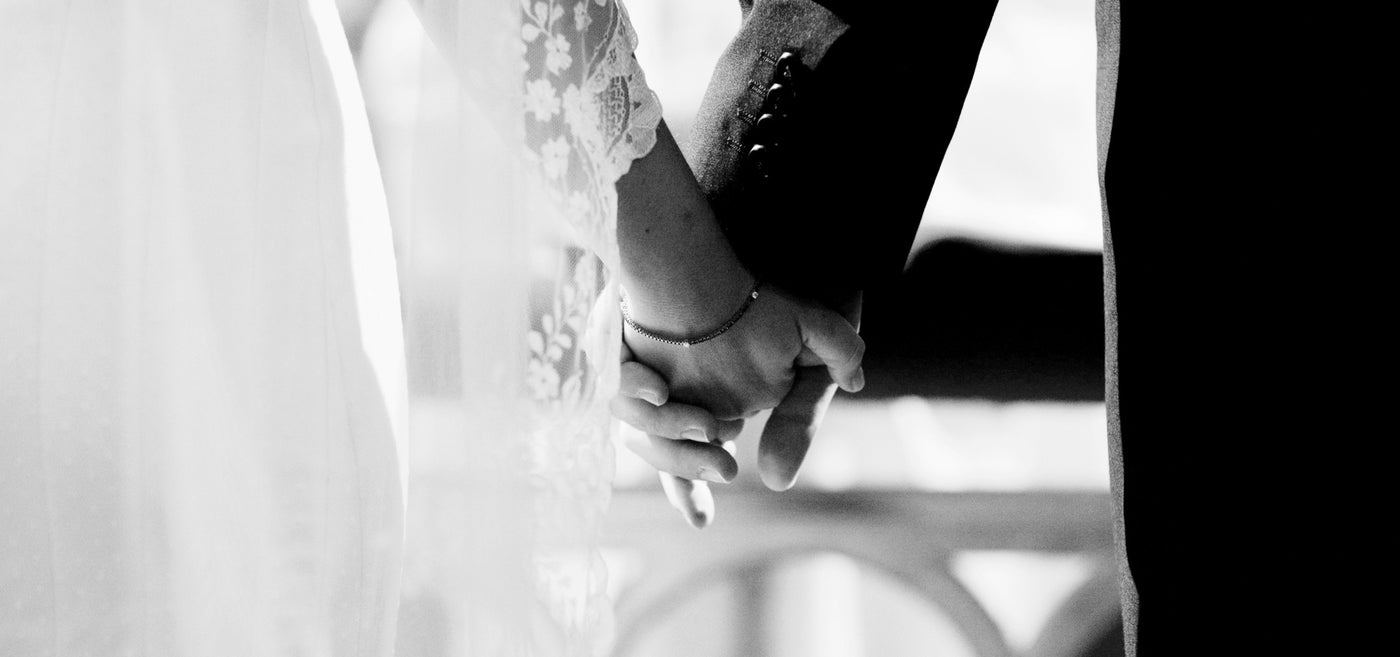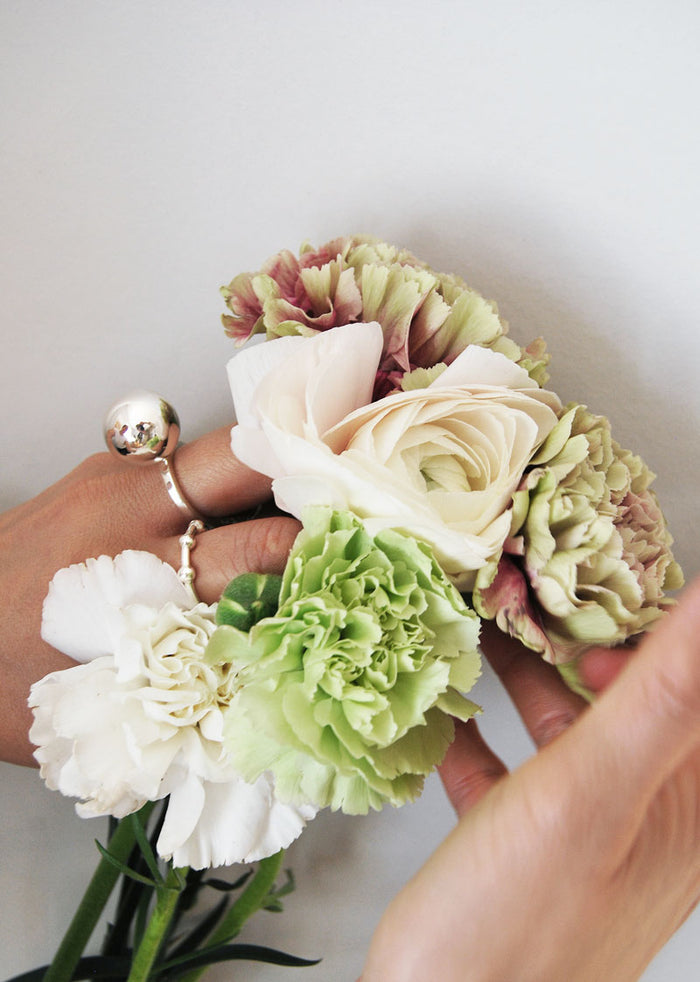When it comes to choosing engagement rings and wedding rings, you encounter a variety of questions, concerns, and unfamiliar concepts.
In Mila Silver's big Guide to Wedding and Engagement Rings, we tell you what the most common ring models are, what the four Cs of diamonds are, which ring is for wedding and engagement, and how to find out your partner's ring size on the sly...

These are the most common days to propose
Christmas Eve is the most popular day to kneel.
Christmas is a time for spending time with family and friends, which makes it a popular time to propose.
Then comes New Year's Eve , which many think is a perfect time to propose. Proposing when a new year begins is a symbolic gesture that marks a new beginning together.
On Valentine's Day (February 14), many people get down on one knee and propose. A romantic day when many feel inspired to take the step to propose.
Then Midsummer Eve actually comes. The tradition of picking 7-9 kinds of flowers in silence and placing them under the pillow may contribute to the romantic feeling of this day.
Other days that are popular to get down on one knee and propose are summer during the holidays, on trips, anniversaries when you met or to propose on your partner's birthday.
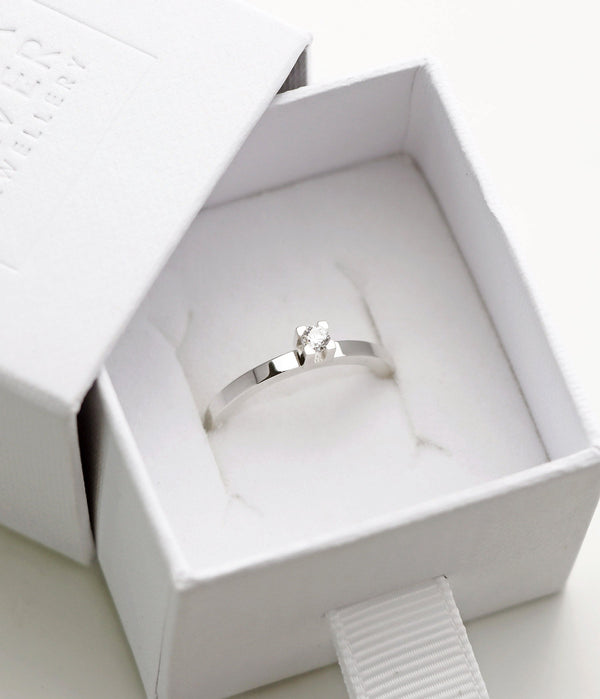
Before the proposal - How to find out the ring size on the sly
If you're going to propose, you probably don't want to reveal yourself by asking about your partner's ring size. So how are you supposed to find out the size on the sly?
Measure a ring your partner already has
If your partner has a ring that you know fits on their left ring finger - visit a shop to measure the ring or measure it yourself. Read more about how to measure rings in the Size guide for rings .
Buy a simple engagement ring for the proposal
Buy a plain silver ring for the proposal in a size you think will fit. Should it not fit, you can return it and order the "real" engagement ring later.
Look at rings together
Maybe you have talked about getting engaged at some point in the future.
Visit a store and look at rings together. Keep an eye on which size fits when your partner tries on rings;)
Ask a friend or relative
Maybe someone close to you knows what ring size your partner has.
Ask around, someone may have bought a ring as a birthday or Christmas present.
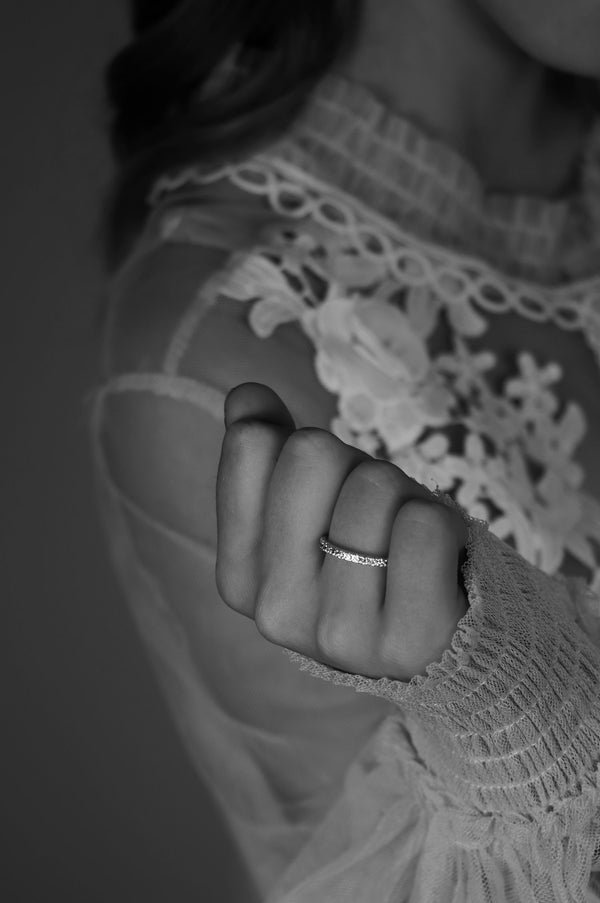
The engagement ring
For many, the engagement ring is the first ring they choose and the one you will wear the longest.
Here are some tips on how to choose an engagement ring.
Choose a design that you want to wear for a long time
Feel for the design of rings that you like. The engagement ring does not have to be expensive or trendy, the most important thing is that you find a ring that you will like for a long time.
Try not to be swayed by what other people have or what rings are popular right now.
Choose a ring that you can wear in everyday life. If you have a job where you are active, maybe the ring should not have a stitched stone.
Matching wedding ring
If you are getting married in the near future, it may be good to look at which wedding ring fits the engagement ring. Often there are sets of matching rings that fit together.
Don't know when you will get married - invest in an engagement ring that you like now. It is always possible to find a matching wedding ring later on.
Budget
Think and calculate how much money you want to spend on your rings. Calculate the total budget for both engagement ring and wedding ring for both your partner and yourself.
If you dream of a diamond ring but think rings today are too expensive, a silver diamond ring can be an affordable and smart choice.
Read more about different ring models and train yourself in our diamond school further down.
/ Maria
Designer & owner Mila Silver
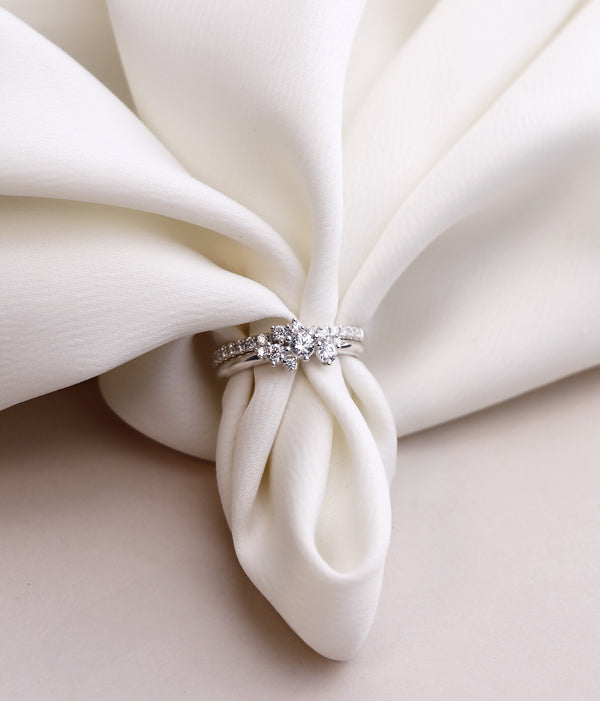
The wedding ring
After the engagement ring comes the wedding ring. The choice of wedding ring is of course influenced by which engagement ring you already have. Here are some tips along the way.
Wedding ring & engagement ring in harmony
Since the rings are worn together, it is important that the rings form a nice unit. The designs can be different, but the height should preferably be the same so that the rings end up at the same level.
It may be wise to buy both rings from the same place because designers often produce rings that match each other and can be worn together.
Differences that lift each other up
Just as important as harmony is that the rings have something that makes them different. The wedding ring and the solitaire ring in the picture are a good example of this. The rings have the same dimensions and the same diamond cut but are different ring models where the wedding ring acts as a base and the solitaire ring is the crowning glory.
Rings of the same height
Remember that the rings should be the same height so that the rings end up at the same level on the finger. The width can differ but the height should be the same. Also choose the same profile on the ring bar so that the wedding ring and engagement ring lie close together.
/ Mary
Designer & owner Mila Silver
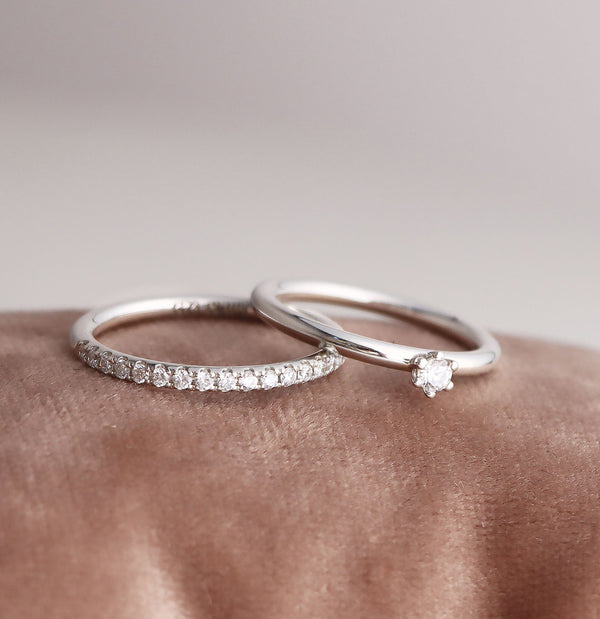
Which ring should I wear as a wedding ring or engagement ring?
A question that many people ponder is which of the rings in a set is for the wedding or the engagement. Is the more expensive ring the wedding ring or the engagement ring?
The answer is that there are no rules. Think about how you want it. Maybe you want a simpler ring for your engagement and add some sparkle to your wedding ring? Or vice versa.
The engagement ring is the first ring you get. If you don't know when the wedding will take place, it is important that you are comfortable with your engagement ring for a long time and can combine it with other rings that you wear in everyday life.
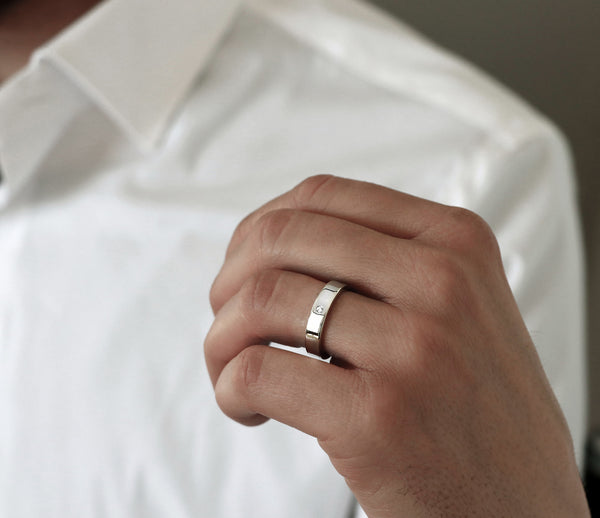
The man's ring is both a wedding ring and an engagement ring
The man's engagement ring is often a plain silver or gold ring that is slightly wider than the woman's ring.
Before the wedding, people often choose to engrave the man's engagement ring, which then turns into a wedding ring.
For men, the range of wedding and engagement rings is somewhat smaller, although this is changing.
We are seeing more and more variations for men and diamond rings for men are also starting to become popular.
The most common ring models for weddings and engagements
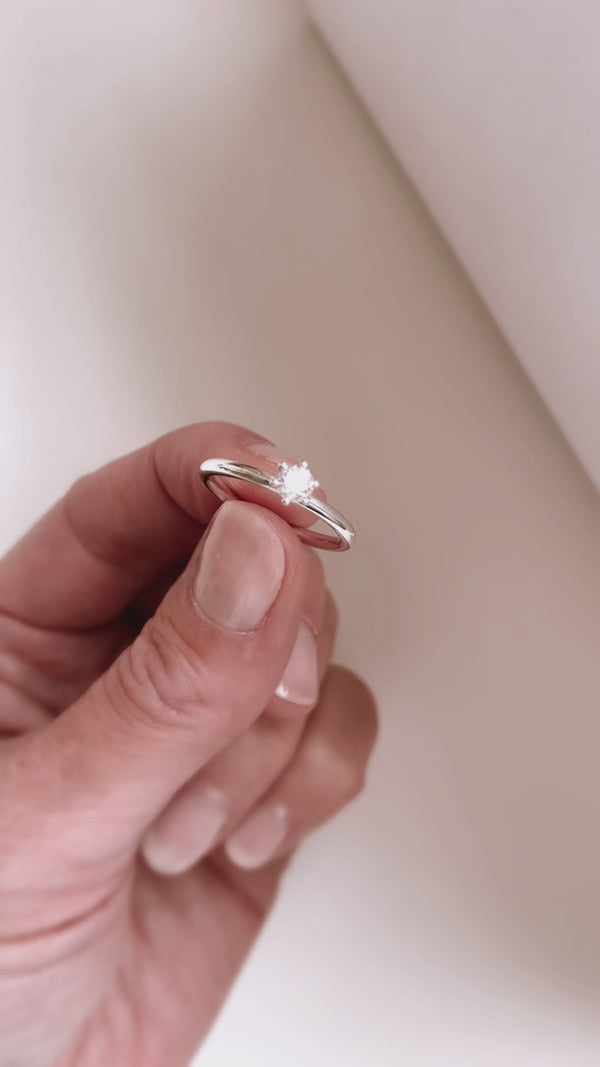
The solitaire ring - ring with a diamond in focus
The solitaire ring is a wedding or engagement ring with a diamond.
This is a beautiful and classic ring model that is available in many different designs and styles.
The diamond can have different weights (carats) and different cuts. The most common solitaire ring is a ring with a round brilliant cut diamond .
But rings with oval diamonds and cushion-cut diamonds are also popular solitaire rings.
The solitaire ring can be worn as both a wedding ring and an engagement ring.
If you choose to wear the solitaire ring as an engagement ring, think about which ring you should combine it with for the wedding.
A classic and beautiful option is to wear the ring with an alliance ring that has a band of small diamonds or a plain ring .
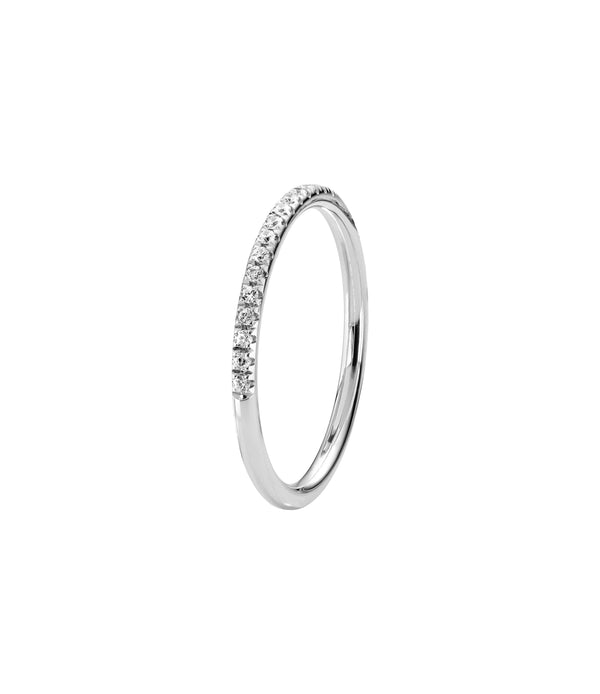
The wedding ring - ring with a band of diamonds
The wedding ring is a classic and timeless wedding or engagement ring with a band of diamonds that sit tightly together.
The English word Eternity band ring describes what the ring means - eternal love.
The ring can be a full-alliance ring where the diamonds go around the entire ring or a half-alliance ring as in the picture.
If you choose a half-alliance ring , you don't have to worry about the diamonds getting damaged on the underside of your finger.
The wedding ring can be worn as both a wedding ring and an engagement ring. It is often combined with a solitaire ring or a plain ring.
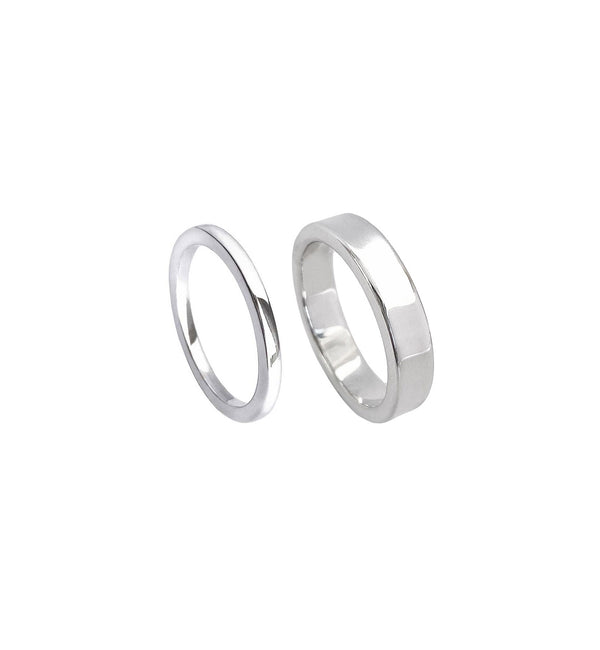
Set of plain silver engagement rings
A set of plain silver rings for your engagement or wedding is stylish and beautiful. The plain ring is beautiful in its simplicity and is a perfect choice if you are proposing and want to decide on wedding rings together later.
The plain silver engagement ring can serve as a base for her to build on with a diamond wedding band. You can also set the ring with diamonds at a later stage.
The man's plain engagement ring also becomes a wedding ring after the wedding and can then be gilded with an engraving.
The 4 C's of Diamond
To determine the value of a diamond, four different measurements are used. They are often referred to as the 4 Cs of a diamond:
Carat (ct - the weight of the diamond), Colour (the color of the diamond), Cut (the cut/shape of the diamond), Clarity (the clarity of the diamond).
Carat - the weight of the diamond
Carat (ct) is a unit of measurement for the weight of a diamond. One carat is equal to 0.2 grams.
Carat does not determine the size of the diamond in diameter because the cut and the quality of the cut also determine what carat the diamond gets and how big we perceive the diamond to be.
A well-cut diamond is perceived as larger and reflects light better than a poorly cut diamond. The size in mm and the carat are not proportional. For example, a 2 ct. diamond is not twice as large as a 1 ct. diamond. The difference is only about 1.5 mm.
Colour - the color of the diamond
D - E: (River) Very rare white. The highest color quality found on the diamond.
FG: (Top Wesselton). Rare white.
H: (Wesselton). White.
I: (Top Crystal). Very light tinted white.
J: (Crystal). Lightly tinted white.
KL: (Top Cape). Tinted white.
MN: (Cape). Slightly yellowish.
Wedding and engagement rings from Mila Silver are set with TWVS diamonds. That is, rare white diamonds with very small inclusions, see the table for clarity below.
Clarity - the clarity of the diamond
The clarity of a diamond is an important measure of the diamond's appearance and quality.
Clarity refers to the purity of the diamond. That is, how few inclusions the diamond has. This is assessed with a loupe at 10x magnification.
FL, IF
Flawless
HVAC, HVAC2
Very, very small inclusions
VS1, VS2
Very small inclusions
SI1, SI2
Small inclusions
I1, I2, I3
Pique included
Cut - the diamond's cut
The diamond cut quality scale shows how well the diamond reflects light. If the diamond's cut reflects a lot of light, the diamond is perceived as very sparkling.
Grinding qualities : Ideal - Excellent - Very Good - Good - Fair - Poor.
The different shapes of diamonds
BRILLIANT (round)
Brilliant cut diamonds are the most common diamond cut and the cut that most people choose for their wedding or engagement ring . Brilliant cut diamonds have a very beautiful luster with maximum light reflections.
Brilliant cut diamonds are usually round with 57 facets.
EMERALD (emerald/rectangular)
Emerald cut diamonds are rectangular with straight edges. This cut has small steps on the sides with a flat surface in the middle. Since this cut makes inclusions more visible, you should choose a high quality diamond.
OVAL
Oval diamonds are timeless and give a neat and elegant expression. The oval diamond has become increasingly popular for those who want a wedding or engagement ring with a different shape than the usual round. The oval diamond has the same fine cut and luster as round brilliant cut diamonds.
CUSHION (cushion)
The cushion cut diamond is square with rounded corners. Cushion cut diamonds come in different cuts, the most common being the Cusion Brilliant, which has the same cut as the round brilliant cut diamond.
PRINCESS (square)
Princess cut diamonds are square with sharp corners.
The cut is classic with many reflections and beautiful luster.
Wedding and engagement rings from Mila Silver are mainly set with lab-grown diamonds.
Here we explain what the difference is between a lab-grown diamond and a natural diamond and what our diamond quality TWVS means.
Facts about lab-grown diamonds
A lab-grown diamond is created by recreating the natural formation of a diamond. It uses a fragment of a natural diamond and then subjects it to pressure and high heat. This process is significantly shorter (weeks) and can be done anywhere in the world with a few people involved.
The result is a traceable and conflict-free diamond with minimal impact on the environment.
A lab-grown diamond has the same physical, chemical and optical characteristics as a natural diamond. The appearance, luster and quality are identical.
What is the difference between a Lab Grown Diamond and a Natural Diamond?
Natural diamonds are formed deep in the bedrock (160-200 km below the Earth's surface) by compressing carbon under high pressure and heat. This process takes many millions of years.
The diamonds are dug up in countries such as Botswana, Canada and Russia and then cut and polished in Antwerp or India.
A lab-grown diamond is created by recreating the natural formation of a diamond. It uses a fragment of a natural diamond that is then subjected to pressure and high heat.
This process is significantly shorter (weeks) and can be done anywhere in the world with a few people involved.
The result is a traceable and conflict-free diamond with minimal impact on the environment.
A lab-grown diamond has the same physical, chemical and optical characteristics as a natural diamond.
About black diamonds
There are two types of black diamonds: Natural black diamonds, which are extremely rare and precious, and treated black diamonds. Treated or colored black diamonds are the most common type of diamond used in black diamond jewelry. The diamond gets its color by radiation treating natural diamonds. Often, natural diamonds are chosen that have many inclusions and are gray in color before treatment.
Are black diamonds real diamonds?
Yes! Black diamonds are natural diamonds that are radiation treated to get their dark color.
/ Mary
Owner & Designer Mila Silver

